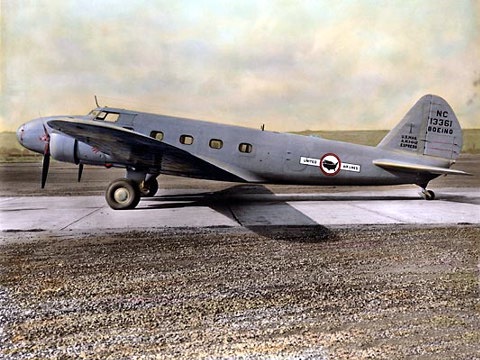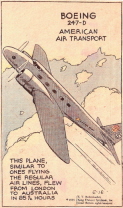First modern airliner
All-metal, twin-engine, low-wing monoplane – 180 MPH
an aircraft featured on the Hall of Fame of the Air
Looking at old airplanes, they seem incredibly archaic — with two wings, made of wood and cloth, open cockpits, struts and wires all over. But the 1933 Boeing Model 247 suddenly resembles modern aircraft. Not that I would expect to jump into such a machine if it pulled up to the gate at LaGuardia, but the 247 is recognizeably modern. While the Douglas DC-1 set the stage for the DC-3 to become the most widely used airliner of the Forties, the prototype of Boeing’s 247 flew on February 8, 1933, five months before the DC-1.
[ad#ad-1]An all-metal, twin-engined, low-winged monoplane, the Model 247 was powered by two 550-horsepower Pratt & Whitney Wasp radial engines. and with retractable landing gear as well, it showed aerodynamic qualities. Lightweight alloys reduced its weight. It could fly over 180 MPH, it could climb on one engine with a full load, and it was also the first airliner to use wing flaps. Its final version, the 247D, had variable-pitch propellers and improved performance at higher altitudes to compete with the Douglas DC-2. It had room for 10 passengers, two pilots, and a stewardess, plus mail and baggage. Only 75 were ever built.
Development
As 1930 approached aircraft designers were getting away from wooden biplanes, turning to all-metal monoplanes. Boeing Aircraft Company pioneered metal aircraft, using welded steel tubes in the fuselage frame, the prevalent technology until superseded by monocoque sheet metal strucures in the next decade.
Boeing’s first all-metal monoplane was the Monomail, a cargo and mail aircraft, introduced in May 1930. The Monomail had a sleek, aerodynamic low-wing design, cantilever construction, retractable landing gear, a streamlined fuselage, and an engine covered by a cowling. Only one Monomail Model 200 was built; it was later modified for long-distance passenger service as Model 221A. The Monomail’s design was too advanced for the engines and propellers that were available in 1930. The airplane required a low-pitch propeller for takeoff and climb and a high-pitch propeller to cruise. By the time the variable-pitch propeller and more powerful engines were available, newer, multiengine planes replaced it. The Monomail inspired the B-9 bomber, the U.S. Air Corps’ first all-metal monoplane bomber, which first flew in April 1931. The two-engine plane could make 186 MPH, had semi-retractable landing gear and metal construction. While the B-9 never progressed beyond prototype, it also influenced the Boeing 247.
Three key men — President Phillip G. Johnson, Vice President Claire Egtvedt, and Chief Engineer C. N. Monteith — chose to develop the transport potential of the Boeing B-9 twin-engine bomber.
Their development of the 247 was difficult and full of disagreements. Boeing’s chief engineer R.J. Minshall wanted a plane no larger than the planes in current production, citing pilots’ preferences and the expense of larger hangars. Fred Rentschler of Pratt & Whitney and Igor Sikorsky (both members of United’s parent corporation), favored a larger plane that would offer more comfort to passengers on long flights. The small plane advocates prevailed, and the 247 only seated ten passengers and a wing spar protruded across the cabin aisle. In spite of the added weight, a co-pilot was added, in the interest of safety and comfort. In another bit of foresight, the design accommodated a (larger) variable-pitch prop, even though the prototype was fitted with an ordinary fixed-pitch propeller. In the later model 247D, the variable-pitch prop was included.
The first 247 flew on February 8, 1933, a year later than planned. It went into service with United on March 30, and most of the first 25 planes were delivered during April and May.
The twin-engine Boeing 247 made the common Ford and Fokker trimotor airplanes obsolete and gave an enormous boost to the U.S. airline industry. United Air Lines purchased 60 of the planes; the remaining 15 went to other customers including Roscoe Turner, Clyde Pangborn, and Lufthansa. Many great aircraft built between the wars participated in air races; such contests were also excellent proving grounds for new or established production types. So, when the MacRobertson Race from England to Australia was organized in 1934, a Boeing Model 247D was entered. Flown by Col. Roscoe Turner and Clyde Pangborn, it gained second place in the transport section, behind its great rival the DC-2.

Specifications:
Wing span: 74 ft (22.6 m)
Length: 51 ft 7 in (15.7 m)
Height: 12 ft 6 in (3.8 m)
Wing Area: 836.44 sq ft (77.70 sq m)
Empty Weight: 8,940 lb (4,055 kg)
Gross T/O Weight: 13,650 lb (6,192 kg)
Maximum Speed: 200 mph (322 km/h)
Service Ceiling: 25,400 ft (7,740 m)
Rate of Climb: 1,150 ft (350m)/min
Normal Range: 800 miles (1,297 km)
Engines: Two Pratt & Whitney Wasp S1H1-G, 550 hp, 9-cylinder radial engines.
Operational History
When the plane’s rollout finally occurred, some 15,000 visitors came to see it. The passenger cabin had soundproofing, a lavatory (although no mirror or running water), individual air vents and reading lights, and heating and cooling that were thermostatically controlled. Its navigation instruments included an autopilot and two-way radio.
[ad#ad-1]
On display at the 1933 Chicago World’s Fair, it was estimated that 61 million people viewed it. The success of the plane provided a response to the aerial feat of Italy’s air minister, General Italo Balbo, who had just led a fleet of 24 Savoia-Marchetti flying boats across the Atlantic Ocean from Rome to Chicago. On June 12, 1933, the 247 made its first transcontinental commercial flight, flying from Newark to San Francisco in only 21 hours. On its return flight, it shaved another hour off that time. Imagine! Flying from coast to coast in just under 20 hours.
United Air lines had great success with its sixty planes for the relatively short time that it flew them. Many of United’s aircraft were later purchased by Western Airlines.
On October 10, 1933, a United Airlines Boeing 247 was the victim of the first proven case of sabotage of a commercial airliner. The aircraft, en route from Cleveland to Chicago, was destroyed by a nitroglycerin-based explosive device over Chesterton, Indiana.
The Young Marshal
One 247D went to China, purchased by young warlord Chang Hsueh-liang, called the “Young Marshal,â€

Imported from other subdirectory